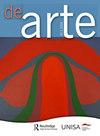In Order to Know, We Must Imagine for Ourselves: How Artworks by Penny Siopis and Anton Kusters Re-present Traumatic Histories for Participatory, Open-Ended Re-imaginings
IF 0.1
0 ART
引用次数: 0
Abstract
Abstract There are historical events that remain charged with trauma, thereby resisting the logic of causal progress conventionally ascribed to historical narratives. As obstacles to cohesive representations of history and national identities, these events remain ambiguous and problematic. Prompted by art historian and philosopher Georges Didi-Huberman’s proclamation “In order to know, we must imagine for ourselves” (Images in Spite of All. Chicago: Chicago University Press, 2012, p. 3), I argue that art, by not being intent on resolution or certitude, can offer opportunities to re-present, re-imagine, and re-think traumatic histories. In this article, I bring a selection of films by South African artist Penny Siopis, namely Obscure White Messenger (2010), The Master Is Drowning (2012), and Communion (2011), into conversation with the installation The Blue Skies Project (2018) by Belgian photographer Anton Kusters. I investigate how they engender affective encounters that probe the limits of the known. This is made possible by the artworks’ tangential approach to the events, activating the viewer’s imagination. The imagination facilitates a subjective, contingent, and indeterminate inquiry into the unknown, which the discipline of history often precludes. As viewers are tasked with the work of making meaning, I argue for the unique potential of art and the imagination as highly generative sources for engendering varying and differing expressions of knowledge that remain open-ended. Central to my argument is the way in which the artworks discussed grapple with the dialectics of the image, with the imbrication of the evidentiary and the imagination—knowing and un-knowing.为了了解,我们必须为自己想象:佩妮·西奥皮斯和安东·库斯特斯的艺术作品如何以参与式、开放式的重新想象再现创伤历史
有些历史事件仍然充满创伤,因此抵制传统上归因于历史叙事的因果进展逻辑。作为对历史和民族身份的凝聚力表现的障碍,这些事件仍然是模糊和有问题的。艺术史学家和哲学家Georges Didi-Huberman的宣言“为了了解,我们必须为自己想象”(Images In Spite of All)。芝加哥:芝加哥大学出版社,2012年,第3页),我认为艺术,不专注于解决或确定性,可以提供机会来再现,重新想象和重新思考创伤的历史。在这篇文章中,我将南非艺术家Penny Siopis的电影选集,即晦涩的白色信使(2010),大师溺水(2012)和交流(2011),与比利时摄影师Anton Kusters的装置作品“蓝天计划”(2018)进行对话。我研究它们如何产生情感接触,从而探索已知的极限。这是通过艺术作品与事件的切线方式来实现的,激活了观众的想象力。想象力促进了对未知事物的主观的、偶然的和不确定的探索,这是历史学科经常排除的。由于观众的任务是创造意义,我认为艺术和想象力的独特潜力是高度生成的来源,可以产生各种不同的知识表达,这些表达仍然是开放式的。我的论点的核心是讨论的艺术作品如何与图像的辩证法、证据和想象的交织——知道和不知道——作斗争。
本文章由计算机程序翻译,如有差异,请以英文原文为准。
求助全文
约1分钟内获得全文
求助全文

 求助内容:
求助内容: 应助结果提醒方式:
应助结果提醒方式:


